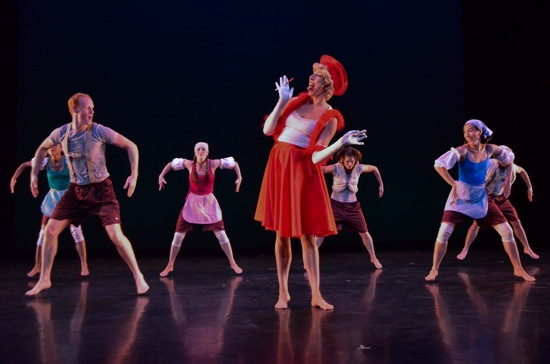
Deborah Lohse smokes while the von Trapp kids put on a puppet show in Doug Elkins’s Fräulein Maria. Photo: Taylor Crichton, courtesy of Jacob’s Pillow Dance Festival
So long, Fräulein Maria. Also farewell, auf wiedersehen, goodbye. Not au revoir, but (gulp) adieu. I’m not talking about the heroine played by Julie Andrews in the film based on the Broadway show, The Sound of Music; I refer to Doug Elkins’s fabulously funny and adorable, gender-corkscrewing take on Rodgers and Hammerstein’s beloved creation. Fräulein Maria’s touring days are done. It will disappear after its last performance (Sunday, September 26th) during the final week of Jacob’s Pillow’s 80th Anniversary Season (sniff).
Elkins once told me that the process of making Fräulein Maria, after several years of not choreographing, was akin to the collecting mania that drove Renaissance men of wealth to create “cabinets of curiosities.” Back in 2006, watching the movie over and over with colleagues yielded not just an affectionately outrageous deconstruction of an icon, but shards gathered during Elkins’s travels through hip-hop and postmodern dance, his students days, and fleeting references to remembered images from popular and classical artworks. His piece doesn’t follow the musical’s entire plot, but traces elements of it through the songs, which the audience hears through the original-cast recording.
For three Decembers (2006-2008), New Yorkers crammed into Joe’s Pub to see Fraulein Maria, part of DanceNOW’s Dancemopolitan’s Holiday Series. Two Marias climbed over tables and patrons to get to the tiny red stage. We fell in love.
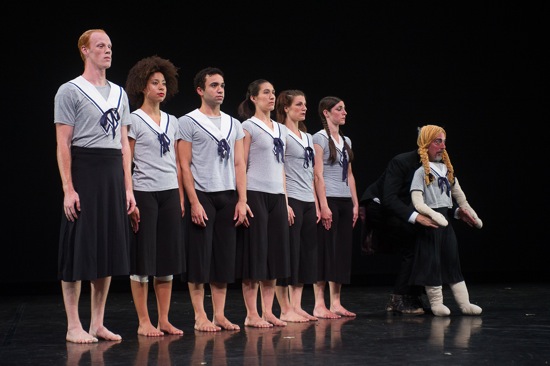
The von Trapp children line up to meet Maria, with Michael Preston standing in as little Gretl. Photo: Christopher Duggan, courtesy of Jacob’s Pillow Dance Festival
Elkins kept tweaking and expanding the piece within that confined and intimate club space. By the time it made its Jacob’s Pillow debut in the summer of 2009, it was ready to tour as a down-home spectacle. In 2012, as then, a compère, the tireless Michael Preston, cajoles the audience into singing the notes, “Do re mi,” in three antiphonal groups as a lead-in to the show. And whaddya know? Minutes later, he gives the barest of signals, and we’re off: “Do, a deer, a female deer. . . ,” launching into the whole educational catalogue that Maria charms the von Trapp kids into performing. As in 2009, almost everyone else in the 13-person cast collaborates to create instant Alps out of strips of fabric that they hold up. Preston brings tiny trees and a tiny Maria doll to simulate the overhead shot that opens the movie, while Andrews’ recorded voice exults that “the hills are alive” (which in this case, they definitely are).
Several of Fräulein Maria’s numbers are wonderfully choreographed. The ten nuns in hoodies with a hint of wimples who deliver “Maria,” the terrific song about the sweet, rebellious novice, are arranged in order of size, and among their patterns is a gesture that travels down the line, à la Radio City Music Hall, or maybe channelling Giselle’s wilis dispatching Hilarion. In a quintet led by that great dance comedienne, Deborah Lohse, as the Abbess, the nuns grasp one another, hand to elbow, to create a rippling wave that refers both to hip-hop and “How do you keep a wave upon the sand?” “Do-Re-Mi” is an ingenious visual analogy to the song’s buildup of the children’s individual contributions into a contrapuntal whole.
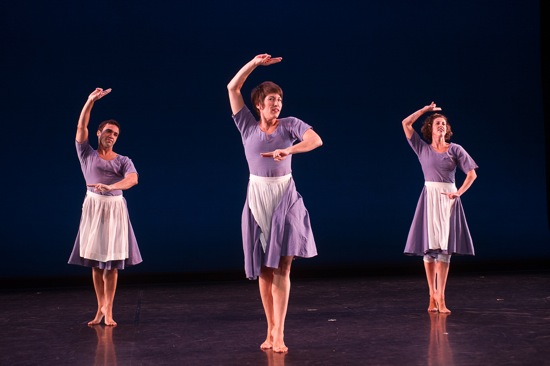
The three Marias, (L to R) Joshua Palmer, Meghan Merrill, Donnell Oakley. Photo: Christopher Duggan, courtesy of Jacob’s Pillow Dance Festival
The original production featured two Marias (one the incomparable Arthur Aviles), who could embody the heroine’s shilly-shallying about her potential job with the widowed Captain von Trapp and his seven children—one of the Marias worried, one trying to be bold. Megan Merrill and Donnell Oakley roughhouse their way through this, the springy athletics of hip-hop mating with the free-flow of postmodern dance. But it’s a third Maria (Joshua Palmer), who’s pushed out of the nunnery and provided with vest, hat, and valise by Preston.
The costumes by Barbara Karger and Robin Staff are key, especially since most of the performers play several roles. The three Marias wear identical blue-gray dresses and white aprons. When one of them eyes a trundled-on window with flowered curtains, the children instantly reappear in variously cut garments of the same material (a cleverly engineered joke about the film heroine’s amazing overnight stitching job).
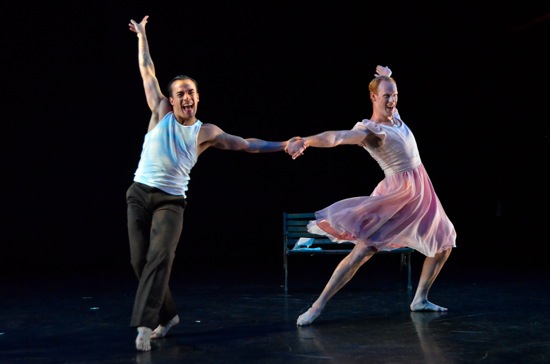
Alexander Dones as Rolfe and John Sorensen-Jolink as Liesl in “Sixteen Going on Seventeen.” Photo: Taylor Crichton, courtesy of Jacob’s Pillow Dance Festival
Gender-role switches and cross-dressing are crucial to Elkins’s vision. In the original production, the eldest daughter Liesl was played by David Parker and her budding Nazi boyfriend by that master of voguing Archie Burnett—both of them mid-sized, solidly built guys. The 2012 Liesl is John Sorensen-Jolink, a tall red-head; her Rolfe, Alexander Dones, is considerably smaller —Brandoesque in his swagger and nimble in his hip-hop moves. They make a comical pair and Sorensen-Jolink in his pink dress delivers the fairly coarse crotch jokes about his partner’s equipment with a mixture of innocent curiosity and wink-wink bawdiness.
When the paterfamilias (Daniel Charon) and Merrill finally declare their love in a rapturous duet, he duplicates her earlier maneuver and takes a flying jump into her arms (the audience gasps; he’s no flyweight), and she hoists him into their kiss.
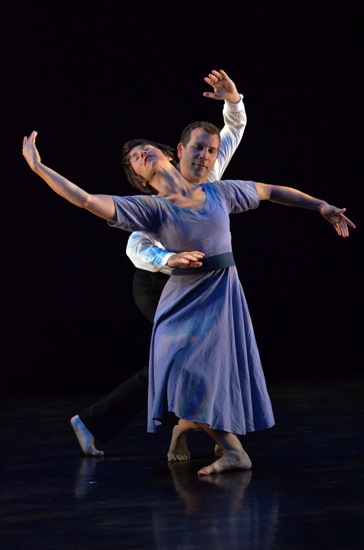
Love at last! Meghan Merrill as Maria and Daniel Charon as von Trapp. Photo: Taylor Crichton, courtesy of Jacob’s Pillow Dance Festival
One of the highlights of Fräulein Maria is Elkins’s solo to “Climb Every Mountain.” He performs it in non-descript dark clothes topped by one of those sacerdotal hoodies. It’s a marvel of slippery movement. He stays in one spotlight and moves as if he’s caught in a never-ending hip-hop routine that he’s dreamed into lyricism. Certain gestures alluding to the song’s words slip by, and the Pillow audience finds the dance funny. Although Elkins performs it slightly less introspectively than he used to, it still seems like a liquification of a personal struggle, marvelous in its concentrated evasiveness, its search for new paths.
Lohse plays the haughty Austrian noblewoman that von Trapp is thinking of marrying in her best Carol Burnett manner, and the nuns and rambunctious children are brought to life by Hilary Brown, Krista Jansen, Kellie Ann Lynch, and Cori Marquis, in addition to Sorensen-Jolink, Palmer, and Dones.
What’s lovely about Fräulein Maria is that it isn’t really a satire. It’s hilarious without bile. Elkins loves The Sound of Music—a film that he and his young children used to watch, a record they used to listen to. The absurdities point no fingers, and the joys and worries are touchingly real.
Addio Maria. It’s been a delight.

No! Fraulein can’t be gone! Just resting I hope! There are still thousands on the WEST COAST that haven’t had the honor of enjoying such a happy, hilarious show! Dough, keep it going!!!
A joyful romp that can be experienced only through the beauty of dance – live on stage. She’ll be back someday when we need her.